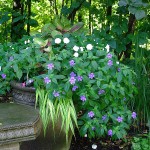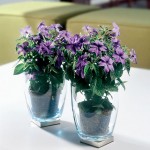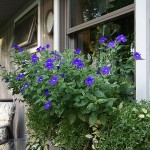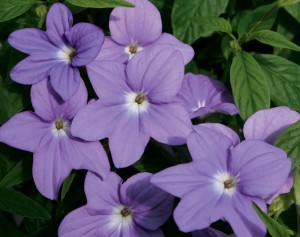Family: Solanaceae
Synonymous: Browallia gigantea
Distribution and habiat: Browallia speciosa is a shrubby, woody perennial native to tropical South America growing in open areas, roadsides, pastures, vacant lots in moist and seasonally dry regions at elevations between 150-1200m (500-4000 feet).
Descriptions: Browallia speciosa is a blue-violet tender perennial usually grown as an annual flowering plant. When grown as an annual, it will typically rise to 0.5m (2 feet) tall. This plant has tubular, 5-lobed, purple-blue flowers with white centres and they are about 5cm (2 inch) wide . The flowers are blooming singly or in small clusters in the upper leaf axils, from late spring to fall. The oval leaves with pointed tips, up to8cm (3 inch) long, are born on the plant. They are a matt-green colour and feel slightly sticky to touch.
Browallia speciosa is grown as a tropical annual. After it produces the show of flowers in its first year or so, it will often begin to decline, therefore it is practical to be discarded and grow a new plant in next spring.
Houseplants care: Indoors Browallia speciosa plants are prized for their vividly coloured, sapphire blue flowers. When grown in pots, their slim stems may need thin support, but they also make attractive trailing plants if grown in baskets.
As Browallia speciosa develop, nip out the growing tips of stems to encourage bushy growth.
Light: Provide a position offering bright light with at least four hours of direct sunlight every day.
Temperature: Browallia speciosa do best if they can be kept at a temperature of 12-16C (54-61F); temperatures much over 18C (64F) will tend to shorten the life of the flowers.
Watering: Water moderately, enough to make the potting mixture thoroughly moist, but allowing the top two-thirds to dry out between waterings.
Feeding: Once new plants are established, begin applications of standard liquid fertiliser every two weeks and continue throughout the whole of the flowering period.
Potting and repotting: Purchesed Browallia speciosa will normally be in 13cm (5 inch) pots of soil-based potting mixture and will not need repotting. They should be discarded after flowering.
Gardening:Browallia speciosa is typically grown as a warm weather annual. Pinch plants back to encourage branching. Prior to first fall frost, some plants may be cut back, planted in small containers and brought indoors for winter flowering.
Make sure to provide good ventilation if growing under glass.
Although cold temperatures will slow its growth considerably, it can tolerate the brisk air well and will continue to flower.
Light: Browallia speciosa plant grows in sun to shade. Blooms best in warm shade. In hot summer areas, plants are best sited in sun dappled conditions, bright shade or afternoon shade.
Soil:Browallia speciosa performs well in humusy, consistently moist, well-drained soils.
Prepare the bed by working in a little compost or sphagnum peat moss. PlantBrowallia speciosa 20 to 25cm (8-10 inch) apart in well-drained soil after the last frost date.
Mulch these plants with dried grass clippings, pine needles, wood chips or another organic material.
Irrigation: Browallia speciosa needs regular water. During the growing period, water moderately and keep it just moist in winter.
Fertiliser: Apply a low-nitrogen liquid fertiliser monthly during the growing season.
Propagation: Propagation of Browallia speciosa is by seed. If it is sown in early spring, plants will begin to flower in early autumn; later sowing will result in later flowering periods. Sow the seed thinly in small pots of moistened rooting potting mixture. Place the pots in a plastic bag or small propagation case and keep them at a temperature of 15-18C (59-64F) in medium light. When seedling are about 1cm (0.4 inch) tall, remove them from the plastic bag or propagator, water them enough to make the potting mixture barely moist and leave them until they are about 5cm (2 inch) tall. Then pot them individually in 8cm (3 inch) pots of soil-based mixture and treat them as mature plants. They should be moved on into 13cm pots (5 inch) after they have filled the smaller size with roots. Alternatively, six to eight small plants can be placed in a hanging basket measuring about 20cm (8 inch).
Recommended varieties:
Browallia speciosa cv. 'Major' general has erect stems 45-60cm (18-24 inch) tall that carry slightly drooping, 5-6cm (2-2.5 inch) long pointed egg shaped, bright green leaves on very short leaf-stalks. Violet-blue flowers 5cm (2 inch) across, which are produced from leaf axils and borne on short stalks, are tubular, but they flare out flat, dividing into five lobes. Most of the flowers have a white throat and some deep blue veining running along the lobes.
Browallia speciosa cv. 'Silver Bells' is a white flowered plant.
Availability: Sow Browallia speciosa seed indoors 8-10 weeks before last spring frost date or purchase spring starter plants in six packs from nurseries.
Problems:
Aphids, leafhoppers and whiteflies may feed on Browallia speciosa new shots and its leaves.
Treatment: Successive sprays of insecticidal soaps or white oil will eradicate both aphids and whiteflies infestations and reduce high populations of leafhopper nymphs; thorough coverage of leaf undersides is important. It is very difficult to control adults effectively and no control is effective.
The base of the plant rots if the plant is given too much water.
Treatment: Once the base has started to turn black the plant cannot be saved and must be discarded.
Yellow leaves occur when the plant is too cold.
Prevention: Keep the plant in a warm position.
The plant is droopy. It needs more water.
Prevention: Water more frequently.
Fungal leaf spots and tomato spotted wilt virus may occur.
Treatment: Fungal diseases can be effectively controlled using recommended range of fungicide either systemic and non-systemic. Plant hygiene will help to prevent these diseases. Ensure proper air circulation. This will help the plant to heal if does experience a fungal or pest infestation that must be treated.
Over fertilisation causes leaf growth at the expense of flower production.
Treatment: Use low-nitrogen liquid fertiliser in small dosage to prevent overfertilisation.
Companion plants: Browallia speciosa will make a stunning display when is planted together with Petunia species,Ipomoea batatas (Sweet Potato Vine) or Lobularia maritima (Sweet Alyssum).
Uses and display: Browallia speciosa is perfect to grow in all kinds of containers or hanging baskets, cascading down a wall. Can be planted in mass or large groups in beds, borders and woodland gardens. It looks great in rock gardens and makes a breathtaking potted specimen plant. It makes a splash of colour on a windowsill, especially if placed among foliage plants. It can be kept as houseplant for bright, warm locations in winter.
SUMMARY:
CHARACTERISTICS:
Foliage green
Features flowers
Shape bushy
Height: 0.5m (2 feet)
PROPER CARE:
Watering in active growth period moderately
Light bright
Temperature in active growth period min 13C max 18C (55-64F)
Humidity low
Hardiness zone: 9-11





